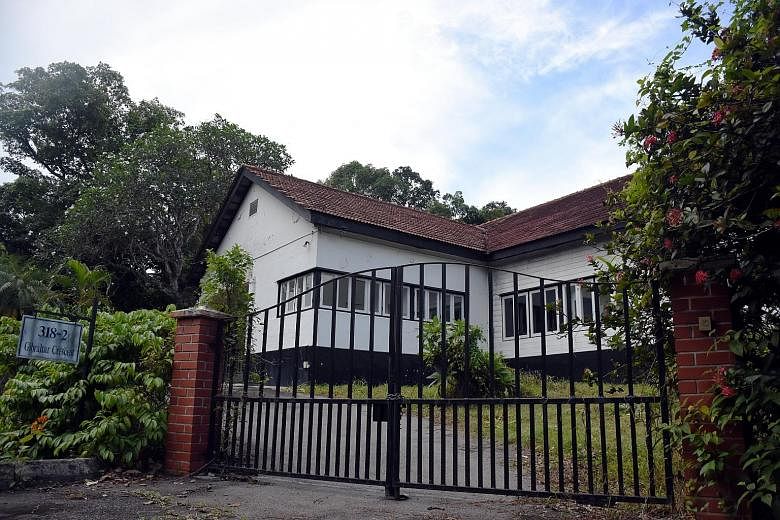In a quiet, forested area near the coast in Sembawang lies a 1950s or 1960s covered gateway supported by two brick lamp posts.
The gateway, located at a clearing in Jalan Mempurong off Andrews Avenue, was most likely the entrance to the seaside bungalow of the late Cycle & Carriage boss Chua Boon Peng, who in 1951 clinched the Mercedes-Benz sole distributorship for what was then Malaya.
Architect Alisdair Ferrie, 60, whose father James bought a property in the area in 1979, said there were four bungalows in total. The Ferries sold theirs before the Government acquired the land more than a decade later.
All the homes are now gone, but the gate reminds one of a time when living by the sea did not come with a multimillion-dollar price tag, said heritage blogger and naval architect Jerome Lim, who has mapped the area's historic naval and military structures.
He said seafront homes were not restricted to Europeans but also included a sprawling network of at least five villages such as Kampung Wak Hassan.

The National Heritage Board (NHB) told The Sunday Times it is now conducting additional research into the area to refresh its heritage trail of Yishun and Sembawang.
The board said it will be expanding content on the World War II structures found in Sembawang, once home to the British naval base.
To support the naval base, which was constructed to defend Singapore in 1938, surrounding structures including more than a dozen World War II bunkers, air-raid shelters and storehouses were built. They are likely to be part of a complex and yet-to-be-discovered underground network.
Remnants and hints of their existence are hidden under Semba- wang's hilly terrain.
They include two partially exposed pillboxes in Bermuda Road, complete with ditches. The pillboxes had slots for machine guns.
A more well-known structure is the air-raid shelter on the grounds of Admiralty House, now gazetted as a national monument. Yet another underground shelter sits at 291 Durban Road. Evidence of its existence comes from the two ventilation shafts sticking out of the ground; what lies underneath is unclear.
NHB said its existing Yishun-Sembawang heritage trail features military-related structures such as St Andrew's Community Chapel, built by the British Royal Navy, a concrete bunker now engulfed by a banyan tree, the former Singapore Naval Base, and streets related to the Royal Navy.
NHB assistant chief executive of policy and community Alvin Tan said the board will be including new and updated information about Sembawang in its trail brochure, map and mobile app when the refreshed trail is launched.
Other significant and little-known buildings in Sembawang include a one-storey wooden building at 318-2 Gibraltar Crescent.
It used to be called the Japanese theatre, and there are differing accounts of what it was. Some say it might have been used to screen propaganda films during the war. Others suggest it was built after the war by Japanese prisoners-of-war (POWs).
Mr Lim hopes the NHB study can shed more light on the area's historic structures.
He said: "Sembawang has retained most of its original landscape, compared with the rest of the country. It deserves our recognition as it played a role in Singapore's development, offering employment for locals at the naval base.
"It has a unique identity that integrates nature with history and has an old-world feel to it."
Sembawang is also home to about 50 black-and-white buildings that are managed by the Singapore Land Authority (SLA). Some of them used to house senior officers of the dockyard. The homes have balconies and were often located on higher ground to offer a vantage point and lookout into the dock.
Among them is the house of the Commodore Superintendent of the Dockyard at 128 King's Avenue. On its lawn lies an ornamental red bridge that was built by Japanese POWs after World War II, said Mr Lim.
This building is currently leased for residential use. An SLA spokesman added that plans for 318-2 Gibraltar Crescent are currently under study.
The roads in the area were also named after former British colonies and existing territories such as Lagos, Delhi, Canberra, Bermuda and Pakistan.
A former navy man, Briton David Ayres, 71, who was based in Singapore for three years in the 1960s, shared stories of the area with The Sunday Times when he returned to Singapore last month for his first visit in decades.
He said there had been a milk bar on the naval base. "It was a little shop with a juke box that sold drinks such as Fraser and Neave's orange soda," he said.
Mr Ayres also documented 1960s Sembawang on his Miranda SLR film camera. Among his pictures is one of the Aggie Weston Sailors' Rest - a recreation centre just outside the dockyard in Canberra Road where navy folk unwound. It had a swimming pool and fitness centre.
It still stands today as HomeTeamNS Sembawang Clubhouse.
Mr Ayres also captured local dockyard workers exiting the gates of Sembawang Road and riding home on their bicycles as the siren from the shipyard sounded to signal the end of the day.
This scene is still repeated in Canberra Road in the evenings today as Sembawang Shipyard workers ride home on their bicycles, although the road has become a dual carriageway.




